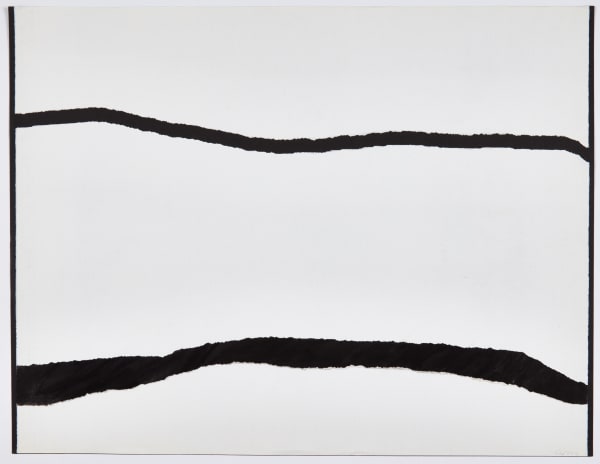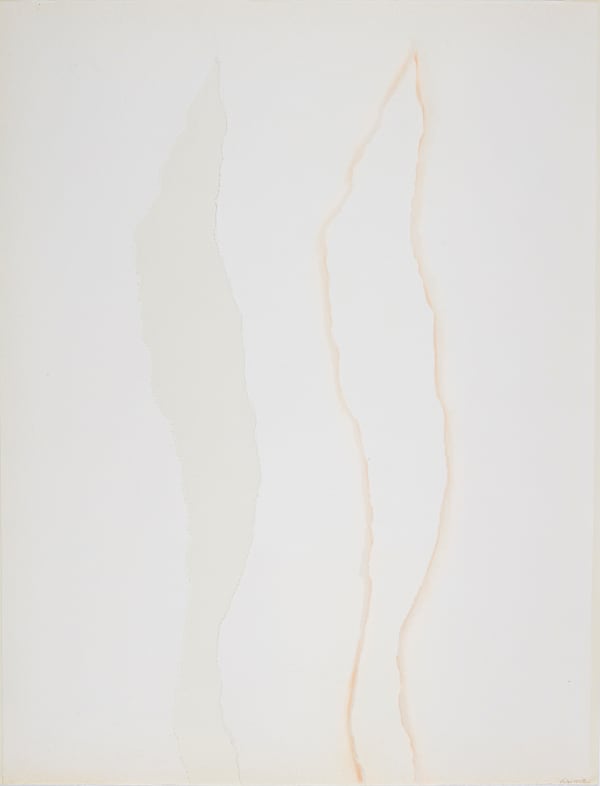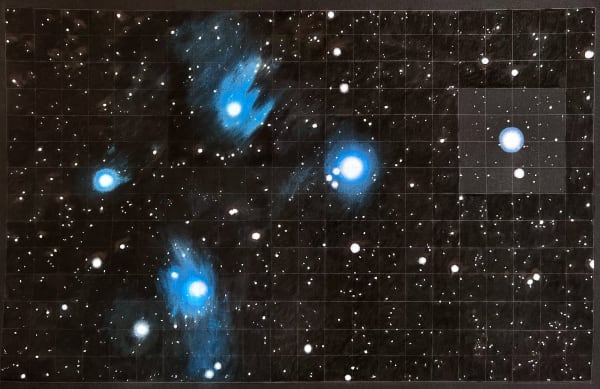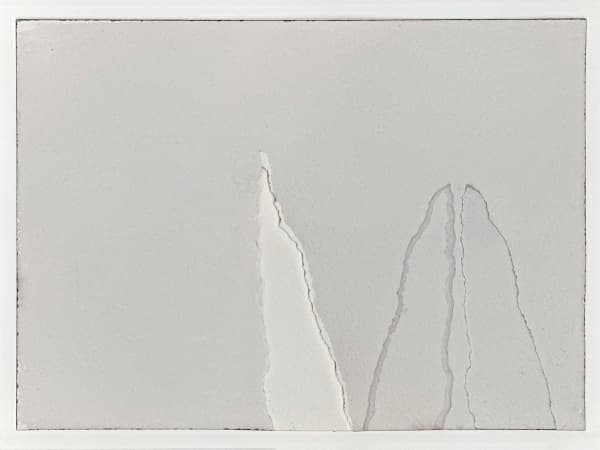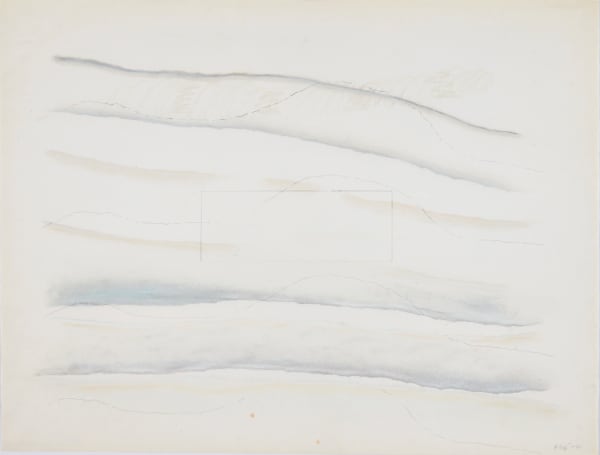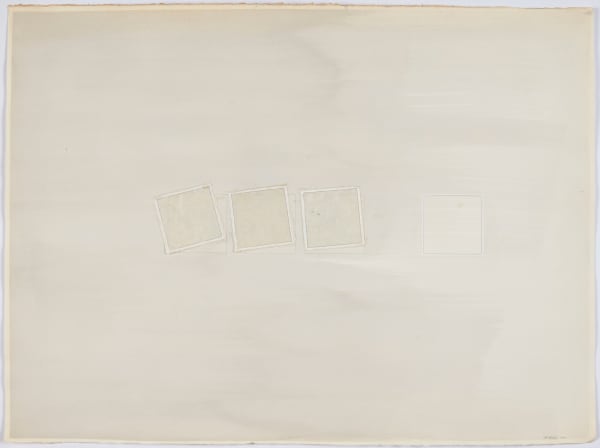-

-
Bilgé: 1975
Curated by Barbara Stehle, Ph. D.Link to full essay by Barbara Stehle, Ph.D.In one of her last journal entries of 1974, Bilgé writes: “74 is the most remarkable, exciting year of my life - I feel sad seeing it fade into the past and feel anxious about 75. What has 75 in store for me? I wish it to be full of work and [the] success of my work.” Indeed, 1974 had been good to her, after sixteen years in the United States, Bilgé had finally broken into the New York gallery scene. Her presence had been noticed by critics and it gave her wings. Her production took off. 1975 would prove to be one of her most prolific years of the decade.
This was an unexpected turn of events since a mere three years earlier, in a radical move, Bilgé had destroyed all her canvases. The only one to escape destruction – a geometrical composition with multiple square -- was not in her studio. The artist was frustrated with the medium and unimpressed with the need for always bigger, larger, louder works:
“I wonder why everyone is so concerned with size. Everybody wants to paint bigger and bigger. […] Man is preoccupied with space and size when he is constrained in small places, like apartments and congested cities. Whereas when you go down to the open ocean, you don’t think about size/space. You are there and you start expanding within, thinking about it. That is how it should be with paintings. A work should take you and let you expand regardless of its size.” -
-
 Bilgé (Turkey/US)Horizontal Line Life Span (torn), 1975Torn paper, pastel, Strathmore paper19 1/2 x 25 1/2 in
Bilgé (Turkey/US)Horizontal Line Life Span (torn), 1975Torn paper, pastel, Strathmore paper19 1/2 x 25 1/2 in
49.53 x 64.77 cm -
 Bilgé (Turkey/US)Horizontal Line Life Span Series 6, 1975Torn paper, pastel, Arches paper19 1/2 x 25 1/2 in
Bilgé (Turkey/US)Horizontal Line Life Span Series 6, 1975Torn paper, pastel, Arches paper19 1/2 x 25 1/2 in
49.5 x 64.8 cm -
 Bilgé (Turkey/US)Horizontal Line Life Span Series (small black torn), 1975Torn paper, pastel, paper19 1/2 x 25 1/2 in
Bilgé (Turkey/US)Horizontal Line Life Span Series (small black torn), 1975Torn paper, pastel, paper19 1/2 x 25 1/2 in
49.5 x 64.8 cm -
 Bilgé (Turkey/US)Poem On a Depressed Day, 1975Torn paper, pastel19 1/2 x 25 1/2 in
Bilgé (Turkey/US)Poem On a Depressed Day, 1975Torn paper, pastel19 1/2 x 25 1/2 in
49.5 x 64.8 cm
-
-
-
In Bilgé’s journals, she spoke of the universal human creations of the “line,” the “square,” and how they embody the human connection to nature. Her practice in 70s/80s became an intense laboratory where she experimented with a subtle but universal vocabulary of numbers, words, lines, dots, and shapes. Through these little known works she raised a question that has an especially profound significance now - the question of the non-Western origins of abstraction. Having grown up in Turkey, Bilgé's spiritual minimalism was influenced by Vedic and Islamic numerology, Sufism, and classical Turkish poetry. She also had a deep fascination with Japanese visual cultures, and the Asian tradition of paper making; her works with fibers and organic materials and shapes were inspired by living in Papua New Guinea. In addition, she engaged with the works of Agnes Martin, Cy Twombly, and especially Robert Motherwell, among her other contemporaries.
-

-
By 1975, Bilgé had become a master of the tear. She knew paper fiber like no one else. Tearing paper has style. The breaking apart is a hand practice that creates unconventional lines. With tears the artist could express exquisite softness, brutal separation, tenuous tension and more. She would play with negative and positive space, color relations and oppositions. The rhythmic nature of it obsessed her. In February 1975 she wrote:
“Rhythms – more must be said about rhythm
Rhythm in lines
Rhythm as TIME
RHYTHM AS TIME
LINE AS TIME
Music as time”
When she collaged forms, Bilgé paid special attention to their spacing, their interactions and the beats they created. Her compositions have musicality, sounds of silence and of waves crashing. With her watercolors, she invented a lyrical minimalism. The romantic in Bilgé came back again and again to the depiction of metaphysical seascapes. Her skies are vast, horizons infinite. One feels the measure of things but never in a mechanical way. Bilgé had a sophisticated and varied understanding of lines. We can perceive in them her unique humanity. Bilgé pulled lines far away from the grid and geometry. She had become a dissident minimalist. Nothing demonstrates this better than the fun she had playing with squares, her old friends. Bilgé dressed up her squares with polka dots, gave them different angles, disturbed their edges. She called them “Mutated Squares”, acknowledging that she had turned them into a new thing, a strange organic geometry. In one of her watercolors, she freed her squiggly squares, sending them flying over the ocean in an Agnes Martin like stripped sky. It is a delight.
- Barbara Stehle Ph.D.
-
-
 Bilgé (Turkey/US)Tide's in #1, 1975Torn paper, pencil, watercolor25.4x35.56cm
Bilgé (Turkey/US)Tide's in #1, 1975Torn paper, pencil, watercolor25.4x35.56cm -
 Bilgé (Turkey/US)Tides in #3, 1975Watercolor, pencil on paper10 x 14 in
Bilgé (Turkey/US)Tides in #3, 1975Watercolor, pencil on paper10 x 14 in
25.4 x 35.6 cm -
 Bilgé (Turkey/US)Tide's in #4, 1975Torn paper, pencil, watercolor10 x 14 in
Bilgé (Turkey/US)Tide's in #4, 1975Torn paper, pencil, watercolor10 x 14 in
25.4 x 35.56 cm -
 Bilgé (Turkey/US)Tides Time (The Menil Collection), 197512 1/8 x 16 1/8 x 7/8 in
Bilgé (Turkey/US)Tides Time (The Menil Collection), 197512 1/8 x 16 1/8 x 7/8 in
30.8 x 41 x 2.2 cm
-
-
Northern Lights Series
-
-
 Bilgé (Turkey/US)Saturday_Srose, 1980Pastel and pencil, signed verso26 x 39 3/4 in
Bilgé (Turkey/US)Saturday_Srose, 1980Pastel and pencil, signed verso26 x 39 3/4 in
66 x 101 cm -
 Bilgé (Turkey/US)Before winter_s grey, 1980Pastel and pencil, signed verso26 x 39 3/4 in
Bilgé (Turkey/US)Before winter_s grey, 1980Pastel and pencil, signed verso26 x 39 3/4 in
66 x 101 cm -
 Bilgé (Turkey/US)Untitled Northern Lights, 1980Pastel and pencil, signed verso26 x 39 3/4 in
Bilgé (Turkey/US)Untitled Northern Lights, 1980Pastel and pencil, signed verso26 x 39 3/4 in
66 x 101 cm -
 Bilgé (Turkey/US)Untitled Birch Edge, 1980Pastel and pencil, signed verso26 x 39 3/4 in
Bilgé (Turkey/US)Untitled Birch Edge, 1980Pastel and pencil, signed verso26 x 39 3/4 in
66 x 101 cm
-
-
Square Mutation Watercolor Paintings, 1935 (4 of 13 shown here)
-
 Bilgé (Turkey/US)Balances and Counter Balances: Square Mutation , 1975Watercolor on paper22 x 30 in
Bilgé (Turkey/US)Balances and Counter Balances: Square Mutation , 1975Watercolor on paper22 x 30 in
55.9 x 76.2 cm -
 Bilgé (Turkey/US)Balances and Counter Balances: One Plus One Plus One is Three, 1975Watercolor on paper22 x 30 in
Bilgé (Turkey/US)Balances and Counter Balances: One Plus One Plus One is Three, 1975Watercolor on paper22 x 30 in
55.9 x 76.2 cm
$110,000 for series of 12 -
 Bilgé (Turkey/US)Balances and Counter Balances: One + One + One, 1975Watercolor on paper30 x 22 in
Bilgé (Turkey/US)Balances and Counter Balances: One + One + One, 1975Watercolor on paper30 x 22 in
76.2 x 55.9 cm
$110,000 for series of 12 -
 Bilgé (Turkey/US)Balances and Counter Balances: Square Mutation Gravity II, 1975Watercolor on paper30 x 22 in
Bilgé (Turkey/US)Balances and Counter Balances: Square Mutation Gravity II, 1975Watercolor on paper30 x 22 in
76.2 x 55.9 cm
$110,000 for series of 12
-
-
"In the recurring motif of what she calls “mutated squares”, Bilgé further develops her search for expanded dimensionality to provide a dynamic appearance to otherwise static geometrical shapes. “How can you make a rigid square do something else?”, she asks. A square is constructed from equally long, strict lines; However, Bilgé’s lines collaborate to strike more flexible poses, as if the square they form was floating in space without gravity. What pose can a square, this collaboration of lines, achieve in collective? In Bilgé’s hands, the squares lift themselves out of the surface that carries them, they assume a materiality that is expressed in their postures. Guided only by their own inner tension and momentum, they warp, curve and float, not as abstractions, but as imaginations of a patch of material, with a character of stiffness or floppiness. In her juxtapositions of mutated squares, Bilgé evokes sequences of poses that unfold themselves and that entirely transcend any flatness, in space or in time."
- Işin Önol
-
-
 Bilgé (Turkey/US)Horizontal Life Span Series (with rectangle), 1974Pastel, pencil on Strathmore paper19 1/2 x 25 1/2 in
Bilgé (Turkey/US)Horizontal Life Span Series (with rectangle), 1974Pastel, pencil on Strathmore paper19 1/2 x 25 1/2 in
49.53 x 64.77 cm -
 Bilgé (Turkey/US)Horizontal Line Life Span Series 5, 1974Pastel, pencil on Strathmore paper19 1/2 x 25 1/2 in
Bilgé (Turkey/US)Horizontal Line Life Span Series 5, 1974Pastel, pencil on Strathmore paper19 1/2 x 25 1/2 in
49.5 x 64.8 cm -
 Bilgé (Turkey/US)Horizontal Line Life Span Series 4, 1974Pastel, pencil on paper19 1/2 x 25 1/2 in
Bilgé (Turkey/US)Horizontal Line Life Span Series 4, 1974Pastel, pencil on paper19 1/2 x 25 1/2 in
49.5 x 64.8 cm
-
-
-
 Bilgé (Turkey/US)5 Square Mutations, 1976Pastel, pencil, watercolor on paper22 x 30 in
Bilgé (Turkey/US)5 Square Mutations, 1976Pastel, pencil, watercolor on paper22 x 30 in
55.9 x 76.2 cm -
 Bilgé (Turkey/US)Square Mutation Benthonic #2, 1976Pastel, watercolor and pencil on paper22 x 30 in
Bilgé (Turkey/US)Square Mutation Benthonic #2, 1976Pastel, watercolor and pencil on paper22 x 30 in
55.9 x 76.2 cm -
 Bilgé (Turkey/US)First Act, 1977Torn paper, pencil24 1/4 x 31 7/8 in (framed)
Bilgé (Turkey/US)First Act, 1977Torn paper, pencil24 1/4 x 31 7/8 in (framed)
61.6 x 81 cm -
 Bilgé (Turkey/US)Between the Acts, 1977Mixed media on paper24 1/4 x 31 7/8 in (framed)
Bilgé (Turkey/US)Between the Acts, 1977Mixed media on paper24 1/4 x 31 7/8 in (framed)
61.6 x 81 cm
-
-









